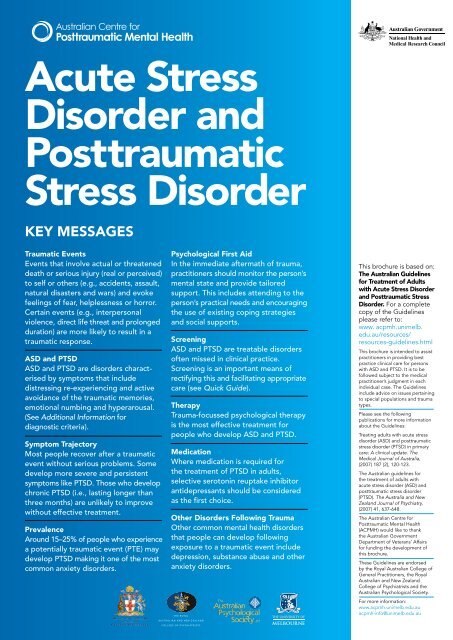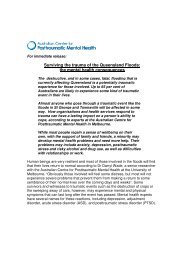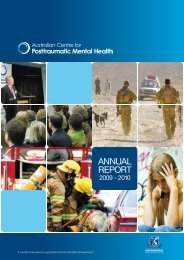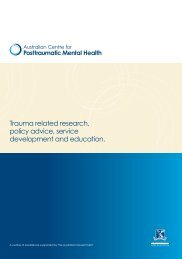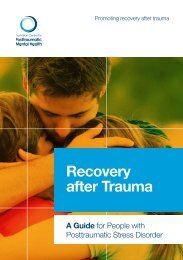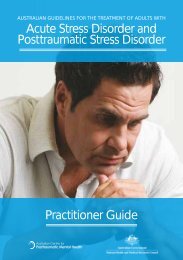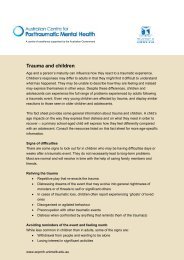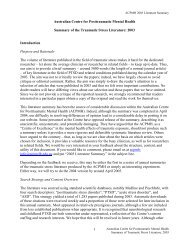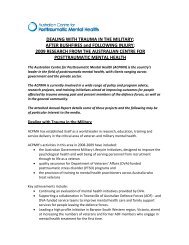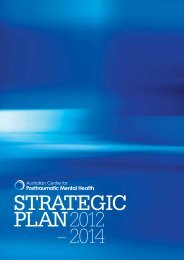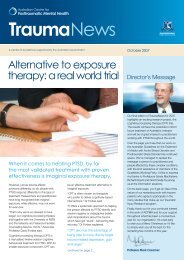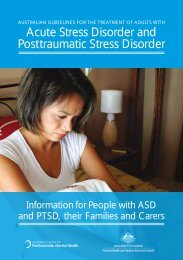Acute Stress Disorder and Posttraumatic Stress Disorder - Australian ...
Acute Stress Disorder and Posttraumatic Stress Disorder - Australian ...
Acute Stress Disorder and Posttraumatic Stress Disorder - Australian ...
You also want an ePaper? Increase the reach of your titles
YUMPU automatically turns print PDFs into web optimized ePapers that Google loves.
<strong>Acute</strong> <strong>Stress</strong><br />
<strong>Disorder</strong> <strong>and</strong><br />
<strong>Posttraumatic</strong><br />
<strong>Stress</strong> <strong>Disorder</strong><br />
Key Messages<br />
Traumatic Events<br />
Events that involve actual or threatened<br />
death or serious injury (real or perceived)<br />
to self or others (e.g., accidents, assault,<br />
natural disasters <strong>and</strong> wars) <strong>and</strong> evoke<br />
feelings of fear, helplessness or horror.<br />
Certain events (e.g., interpersonal<br />
violence, direct life threat <strong>and</strong> prolonged<br />
duration) are more likely to result in a<br />
traumatic response.<br />
ASD <strong>and</strong> PTSD<br />
ASD <strong>and</strong> PTSD are disorders characterised<br />
by symptoms that include<br />
distressing re-experiencing <strong>and</strong> active<br />
avoidance of the traumatic memories,<br />
emotional numbing <strong>and</strong> hyperarousal.<br />
(See Additional Information for<br />
diagnostic criteria).<br />
Symptom Trajectory<br />
Most people recover after a traumatic<br />
event without serious problems. Some<br />
develop more severe <strong>and</strong> persistent<br />
symptoms like PTSD. Those who develop<br />
chronic PTSD (i.e., lasting longer than<br />
three months) are unlikely to improve<br />
without effective treatment.<br />
Prevalence<br />
Around 15–25% of people who experience<br />
a potentially traumatic event (PTE) may<br />
develop PTSD making it one of the most<br />
common anxiety disorders.<br />
Psychological First Aid<br />
In the immediate aftermath of trauma,<br />
practitioners should monitor the person’s<br />
mental state <strong>and</strong> provide tailored<br />
support. This includes attending to the<br />
person’s practical needs <strong>and</strong> encouraging<br />
the use of existing coping strategies<br />
<strong>and</strong> social supports.<br />
Screening<br />
ASD <strong>and</strong> PTSD are treatable disorders<br />
often missed in clinical practice.<br />
Screening is an important means of<br />
rectifying this <strong>and</strong> facilitating appropriate<br />
care (see Quick Guide).<br />
Therapy<br />
Trauma-focussed psychological therapy<br />
is the most effective treatment for<br />
people who develop ASD <strong>and</strong> PTSD.<br />
Medication<br />
Where medication is required for<br />
the treatment of PTSD in adults,<br />
selective serotonin reuptake inhibitor<br />
antidepressants should be considered<br />
as the first choice.<br />
Other <strong>Disorder</strong>s Following Trauma<br />
Other common mental health disorders<br />
that people can develop following<br />
exposure to a traumatic event include<br />
depression, substance abuse <strong>and</strong> other<br />
anxiety disorders.<br />
THE ROYAL<br />
This brochure is based on:<br />
The <strong>Australian</strong> Guidelines<br />
for Treatment of Adults<br />
with <strong>Acute</strong> <strong>Stress</strong> <strong>Disorder</strong><br />
<strong>and</strong> <strong>Posttraumatic</strong> <strong>Stress</strong><br />
<strong>Disorder</strong>. For a complete<br />
copy of the Guidelines<br />
please refer to:<br />
www. acpmh.unimelb.<br />
edu.au/resources/<br />
resources-guidelines.html<br />
This brochure is intended to assist<br />
practitioners in providing best<br />
practice clinical care for persons<br />
with ASD <strong>and</strong> PTSD. It is to be<br />
followed subject to the medical<br />
practitioner’s judgment in each<br />
individual case. The Guidelines<br />
include advice on issues pertaining<br />
to special populations <strong>and</strong> trauma<br />
types.<br />
Please see the following<br />
publications for more information<br />
about the Guidelines:<br />
Treating adults with acute stress<br />
disorder (ASD) <strong>and</strong> posttraumatic<br />
stress disorder (PTSD) in primary<br />
care: A clinical update. The<br />
Medical Journal of Australia,<br />
(2007) 187 (2), 120-123.<br />
The <strong>Australian</strong> guidelines for<br />
the treatment of adults with<br />
acute stress disorder (ASD) <strong>and</strong><br />
posttraumatic stress disorder<br />
(PTSD). The Australia <strong>and</strong> New<br />
Zeal<strong>and</strong> Journal of Psychiatry,<br />
(2007) 41, 637-648.<br />
The <strong>Australian</strong> Centre for<br />
<strong>Posttraumatic</strong> Mental Health<br />
(ACPMH) would like to thank<br />
the <strong>Australian</strong> Government<br />
Department of Veterans’ Affairs<br />
for funding the development of<br />
this brochure.<br />
These Guidelines are endorsed<br />
by the Royal <strong>Australian</strong> College of<br />
General Practitioners, the Royal<br />
<strong>Australian</strong> <strong>and</strong> New Zeal<strong>and</strong><br />
College of Psychiatrists <strong>and</strong> the<br />
<strong>Australian</strong> Psychological Society.<br />
For more information:<br />
www.acpmh.unimelb.edu.au<br />
acpmh-info@unimelb.edu.au<br />
AUSTRALIAN AND NEW ZEALAND<br />
COLLEGE OF PSYCHIATRISTS
Recent Trauma<br />
(Within two weeks of trauma exposure)<br />
Psychological first aid<br />
Monitor the person’s mental state <strong>and</strong> screen for ASD <strong>and</strong> PTSD (see Quick Guide).<br />
Support the person’s use of adaptive coping strategies (e.g., enlisting the support of family <strong>and</strong> friends),<br />
as well as his or her own coping strategies if they seem helpful.<br />
Encourage the person to re-engage in normal routines.<br />
Also:<br />
• Attend to any injuries or physical health concerns.<br />
• Ensure basic needs are met (e.g., housing, safety).<br />
CONTINUED DISTRESS<br />
Most people recover from initial psychological distress. However, if distress/symptoms persist for more<br />
than two weeks, consider diagnosis of ASD/PTSD.<br />
Symptoms may include:<br />
• Distressing or unwanted memories of the trauma<br />
• Avoidance of reminders <strong>and</strong> memories<br />
• Hyperarousal<br />
Risk factors for developing ASD/PTSD include:<br />
• Exposure to severe trauma<br />
• Lack of social supports <strong>and</strong> other stressful life events<br />
• A past history of trauma <strong>and</strong>/or previous psychiatric disorder<br />
TALKING ABOUT THE TRAUMA EXPERIENCE<br />
Support those who want or need to talk about the experience.<br />
Do not push those who prefer not to talk about the experience.<br />
REFERRAL<br />
GPs have an important role in referral <strong>and</strong> care coordination.<br />
Referrals to psychiatry, psychology <strong>and</strong> allied health professionals can be made under Medicare arrangements which may<br />
include completion of a mental health care plan.<br />
When referring for psychological interventions, consider referring to practitioners trained in trauma-focussed interventions<br />
(e.g., CBT).<br />
Referral for mental health care under third party funding arrangements should be considered where appropriate.
ASD/PTSD Suspected or diagnosed<br />
(ASD can be diagnosed between two days to four weeks following trauma. PTSD can be diagnosed from four weeks onward.)<br />
SUPPORT AND SCREEN<br />
Encourage, <strong>and</strong> if necessary facilitate, engagement with social supports.<br />
Stabilise <strong>and</strong> introduce simple stress or anxiety management strategies<br />
(e.g., controlled breathing, exercise or other coping strategies).<br />
Screen for ASD <strong>and</strong> PTSD (see Quick Guide).<br />
REFER OR PROVIDE:<br />
ASSESSMENT<br />
Conduct a thorough assessment of ASD/PTSD, including comorbid diagnoses such as depression, substance<br />
use disorders, safety issues, physical health, social <strong>and</strong> vocational functioning, <strong>and</strong> social supports.<br />
The <strong>Posttraumatic</strong> Checklist (PCL) can be used to assess all PTSD diagnostic criteria.<br />
TREATMENT<br />
First line treatment is trauma-focussed psychological therapy. This includes addressing the traumatic memory<br />
<strong>and</strong> the use of in vivo exposure (for details see Additional Information). Training in the use of trauma-focussed<br />
treatment is recommended.<br />
If one form of trauma-focussed therapy fails to produce a sufficient response, consider another <strong>and</strong>/or the<br />
use of pharmacotherapy.<br />
Trauma-focussed therapy should be embedded in a treatment plan that includes stabilisation, psycho-education,<br />
symptom management <strong>and</strong> attention to key relationships <strong>and</strong> roles.<br />
therapy alternatives<br />
Where no trauma-focussed psychological therapies are effective, available, or acceptable to the person, consider<br />
referral for nontrauma-focussed interventions (e.g., anxiety management) <strong>and</strong>/or pharmacotherapy.<br />
PHARMACOTHERAPY CHOICES<br />
1 SSRI antidepressants (evidence does not distinguish a preferred SSRI)<br />
2 Other newer antidepressants or tricyclic antidepressants<br />
3 MAOI antidepressants (preferably by a psychiatrist)<br />
Where symptoms have not responded to antidepressant treatment, controlled studies have demonstrated potential<br />
benefits of adjunctive atypical anti-psychotics (preferably by a psychiatrist).<br />
Increase dose if non-responsive, being mindful of side effects. If effective, provide 12-month initial course.<br />
Stopping antidepressants should be via gradual weaning. Only use as first line if trauma-focussed psychological<br />
therapy is not available. Pharmacotherapy should always be supported by optimal psychotherapy.
PTSD with comorbidity<br />
Priorities for treatment of comorbid disorders<br />
PTSD <strong>and</strong> Depression<br />
Treat PTSD first when depression is mild to moderate as depression will often improve as PTSD symptoms reduce.<br />
If depression symptoms are severe, however, they should be treated first to minimise suicide risk <strong>and</strong> improve the<br />
ability of the person to tolerate therapy.<br />
PTSD <strong>and</strong> Substance Use <strong>Disorder</strong>s:<br />
Treat both simultaneously because the two are likely to interact to maintain each other.<br />
When treating simultaneously, the substance use should be controlled before the trauma-focussed component of PTSD<br />
treatment begins.<br />
When people present with substance dependence, intoxication or acute withdrawal, the substance disorder should<br />
be treated first.<br />
MANAGING COMPLICATIONS AND PERSISTING PROBLEMS<br />
Safety<br />
People with PTSD may have fluctuating or continued severe distress <strong>and</strong> significant potential for self-harm<br />
(see Severe Distress). These people should be referred for urgent psychiatric care <strong>and</strong> stabilisation.<br />
Treatment<br />
Primary treatment interventions still apply but may involve multiple practitioners (e.g., GP, psychologist,<br />
psychiatrist <strong>and</strong> social/vocational rehabilitation consultants). A high level of communication <strong>and</strong> coordination<br />
of interventions is essential.<br />
Treatment review<br />
If a person’s PTSD symptoms appear to be resistant to change, the following aspects of treatment should<br />
be revised where necessary:<br />
• Consider whether the skill-set <strong>and</strong> experience of the treating practitioner are adequate for the treatment<br />
of the persisting problems.<br />
• Consider referral for a second opinion.<br />
• Consider whether the duration, intensity <strong>and</strong> setting of treatment are appropriate.<br />
SEVERE DISTRESS<br />
If a person presents with severe distress at any stage, particularly if they express thoughts about self-harm<br />
or suicide, appropriate steps to ensure safety include psychiatric care or hospitalisation.<br />
Other indicators of severe distress include severe insomnia, agitation, dissociation <strong>and</strong> social withdrawal.<br />
<strong>Acute</strong> treatment may involve pharmacotherapy using sedating, calming or antidepressant medication.<br />
Long term use of benzodiazepines is not recommended. They do not treat the underlying condition <strong>and</strong><br />
involve risk of dependency.
ADDITIONAL INFORMATION<br />
What is trauma-focussed psychological therapy<br />
First line treatment should be trauma-focussed therapy (trauma-focussed cognitive behaviour therapy (CBT)<br />
or eye movement desensitisation <strong>and</strong> reprocessing (EMDR) in addition to in vivo exposure).<br />
Key elements of trauma-focussed<br />
psychological therapy<br />
Addressing the traumatic memory in a controlled<br />
<strong>and</strong> safe environment (imaginal exposure)<br />
Confronting avoided situations, people or places in<br />
a graded <strong>and</strong> systematic manner (in vivo exposure)<br />
Identifying, challenging <strong>and</strong> modifying biased or<br />
distorted thoughts <strong>and</strong> interpretations about the<br />
event <strong>and</strong> its meaning (cognitive therapy)<br />
As the available evidence does not support the<br />
importance of the eye movements per se in EMDR,<br />
treatment gains are more likely to be due to the<br />
engagement with the traumatic memory, cognitive<br />
processing <strong>and</strong> rehearsal of coping <strong>and</strong> mastery<br />
responses<br />
Treatment duration<br />
Within the overall course of treatmment, 8–12<br />
sessions of trauma-focussed treatment are generally<br />
needed but more may be required for more severe<br />
or complex cases.<br />
Ninety minutes should be allowed for sessions that<br />
involve imaginal exposure.<br />
The development of a robust therapeutic alliance<br />
may require extra time for people who have<br />
experienced prolonged <strong>and</strong>/or repeated traumatic<br />
exposure.<br />
Further sessions may be required where:<br />
• there are several problems that arise from multiple<br />
traumatic events;<br />
• PTSD co-occurs with traumatic bereavement; or<br />
• PTSD is chronic <strong>and</strong> associated with significant<br />
disability <strong>and</strong> comorbidity.<br />
Psychosocial rehabilitation<br />
To reduce the likelihood of an enduring disability, people with ASD <strong>and</strong> PTSD should be actively encouraged to<br />
return to their normal social <strong>and</strong> occupational roles as quickly as they feel able <strong>and</strong> in an appropriately managed<br />
way. This may mean that they will continue to experience symptoms, albeit at reduced levels, as they return to<br />
previous roles. There should be a focus on psychosocial rehabilitation from the beginning of treatment.<br />
SPECIFIC POPULATIONS AND TRAUMA TYPES<br />
For more information on specific populations (Aboriginals <strong>and</strong> Torres Strait Isl<strong>and</strong>ers, refugees <strong>and</strong> asylum<br />
seekers, military <strong>and</strong> emergency service personnel, motor vehicle accident <strong>and</strong> other injury survivors, victims<br />
of crime, sexual assault, natural disasters, survivors of terrorism) download the PDF on these populations<br />
under publications <strong>and</strong> resources at www.acpmh.unimelb.edu.au/for_professionals.html<br />
DSM-IV Criteria for PTSD<br />
A1. The person experienced, witnessed, or was confronted with an event that involved actual or threatened death or serious injury to self or others.<br />
A2. The person’s response involved intense fear, helplessness or horror.<br />
B. Re-experiencing (1 required) C. Avoidance / Numbing (3 required) D. Hypervigilance (2 required)<br />
1. Recurrent <strong>and</strong> intrusive distresssing<br />
recollections of the event, including images,<br />
thoughts or perceptions<br />
2. Recurrent distressing dreams of the event<br />
3. Acting or feeling as if the event were<br />
re-occurring<br />
4. Intense psychological distress at exposure<br />
to internal or external cues that symbolise or<br />
resemble an aspect of the event<br />
5. Psychological reactivity on exposure to<br />
internal or external cues that symbolise or<br />
resemble an aspect of the event<br />
1. Efforts to avoid thoughts, feelings or<br />
conversations associated with the event<br />
2. Efforts to avoid activities, places or people<br />
that arouse recollections of the event<br />
3. Inability to recall an important aspect of the<br />
event<br />
4. Markedly diminished interest or participation<br />
in significant activities<br />
5. Feeling of detachment or estrangement from<br />
others<br />
6. Restricted range of affect (e.g., unable to<br />
have loving feelings)<br />
7. Sense of foreshortened future (e.g., does<br />
not expect to have a normal lifespan)<br />
1. Difficulty falling or staying asleep<br />
2. Irritability or outbursts of anger<br />
3. Difficulty concentrating<br />
4. Hypervigilance<br />
5. Exaggerated startle response<br />
E. Duration of the symptoms (criteria B, C <strong>and</strong> D) is more than 1 month.<br />
F. The symptoms cause clinically significant stress or impairment in social, occupational, or other important areas of functioning.
Quick Guide<br />
for ASD <strong>and</strong> PTSD<br />
If the person reports having experienced a potentially traumatic event:<br />
Is it a recent trauma (within the first 2 weeks)<br />
If yes, provide Psychological First Aid:<br />
• Monitor mental state <strong>and</strong> stabilise if required<br />
• Encourage re-engagement in routines <strong>and</strong> use of social supports<br />
• Ensure basic needs are met (e.g., housing, safety)<br />
• Review in a week or two<br />
If symptoms do not settle following the first 2 weeks, or if the trauma is not recent:<br />
• Assess for ASD or PTSD (ASD can be diagnosed between 2 days <strong>and</strong> 4 weeks;<br />
PTSD from 4 weeks onwards) – see brief screen below<br />
• Consider comorbidity e.g., depression, substance abuse<br />
(see PTSD with Comorbidity for treatment sequencing)<br />
• Ensure stabilisation <strong>and</strong> safety<br />
• Refer for (or provide if appropriate) trauma-focussed therapy (see Additional Information)<br />
• Consider pharmacotherapy<br />
• Encourage resumption or maintenance of family <strong>and</strong> work roles as far as functioning allows<br />
Screen for PTSD<br />
(Prins, et al., 2004, Primary Care Psychiatry)<br />
In your life, have you ever had any experience that was so frightening, horrible, or upsetting that, in the<br />
past month, you:<br />
1. Have had nightmares about it or thought about it when you did not want to<br />
2. Tried hard not to think about it or went out of your way to avoid situations that reminded you of it<br />
3. Were constantly on guard, watchful, or easily startled<br />
4. Felt numb or detached from others, activities, or your surroundings<br />
If two or more are answered with “yes”, a diagnosis of PTSD is probable.<br />
A copy of the screen for PTSD is available at www.acpmh.unimelb.edu.au/trauma/ptsd.html#screening<br />
For a more complete scale including all 17 PTSD symptoms see the PTSD Checklist (PCL).<br />
This scale is useful for diagnostic purposes <strong>and</strong> monitoring change over time.
Quick Guide for ASD <strong>and</strong> PTSD<br />
How do I make a referral<br />
Referrals to psychiatry, psychology, <strong>and</strong> allied health care can be made under Medicare arrangements.<br />
This should include completion of a mental health plan.<br />
Referral for mental health care under third party funding arrangements should be considered where<br />
appropriate.<br />
To whom<br />
Practitioners trained in trauma-focussed interventions (e.g., CBT) are preferred.<br />
• Psychologists: A list of psychologists can be found at:<br />
www.psychology.org.au/findapsychologist<br />
• Psychiatrists: A list of psychiatrists can be found at:<br />
www.racgp.org.au/scriptcontent/ranzcpcomplex.cfmsection=psychiatrist_referral_directory<br />
• Social workers <strong>and</strong> other allied health professionals with mental health training<br />
www.aasw.asn.au/membersdirectory<br />
Mental health plan<br />
• Consider recommendations regarding trauma-focussed CBT for required treatments.<br />
See Additional Information when completing mental health plans.<br />
• In addition to the K10, consider including the PTSD Checklist (PCL).<br />
It can also be used for re-assessment to monitor progress at treatment review.<br />
• Focus on psychosocial rehabilitation: emphasise functional outcomes (e.g., social <strong>and</strong> vocational<br />
goals) from the outset.<br />
Screening for traumatic events<br />
GPs should also ask about past traumatic events where a person has repeated non-specific health<br />
problems.<br />
A good opening question is: Have you ever experienced a particularly frightening or upsetting event<br />
It is often useful to ask about specific events that the person may have experienced, such as the following:<br />
• Serious accident (like a car accident or industrial accident)<br />
• Natural disaster (like a fire or flood)<br />
• Physical attack or assault<br />
• Sexual assault<br />
• Seeing somebody being badly hurt or killed<br />
• Domestic violence or abuse<br />
• Physical or emotional abuse as a child<br />
• Being threatened with a weapon or held captive<br />
• War (as a civilian or in the military)<br />
• Torture or an act of terrorism<br />
• Any other extremely stressful or upsetting event<br />
THE ROYAL<br />
AUSTRALIAN AND NEW ZEALAND<br />
COLLEGE OF PSYCHIATRISTS


